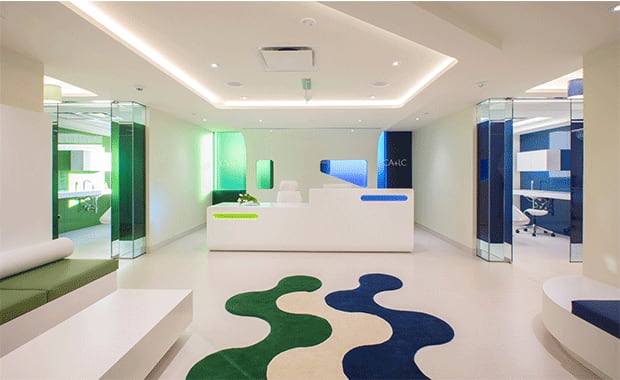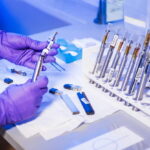Have you ever walked into a clinic and immediately felt at ease, or perhaps the opposite, unsettled? The design and atmosphere of a clinic are often overlooked, but they play a crucial role in a patient’s experience.
Today, the healthcare landscape is highly competitive. So, patients don’t just look at the qualifications of the healthcare provider; they also pay attention to the ambiance and design of the clinic.
Just as you’d likely choose a restaurant based on its ambiance, patients often factor in the clinic atmosphere when deciding where to seek medical services. In this article, we’ll discuss why this matters more than ever. In addition, we will offer tips on creating a clinic space that not only heals but also feels welcoming and approachable.
Why do Clinic Atmosphere and Design Matter?
There are various reasons why your clinic design must be good. Some of the common reasons are:
First Impressions Matter
When your patients first walk into a clinic, their immediate perception influences their trust and confidence in the care they’ll receive. Therefore, it is important to keep a clean, organized, and aesthetically pleasing clinic. It can instantly make them feel at ease.
Emotional Well-being is Tied to Environment
Have you ever noticed how certain colors or designs calm you? Clinics designed with soothing colors and layouts can reduce patient stress and anxiety. It is essential to choose colors that offer peace of mind and overall health.
Efficiency and Functionality Impact Experience
Nobody likes to wait or feel lost. A well-designed clinic ensures smooth flow, minimizing wait times and confusion. When everything is in its right place, both you and the patients can have a smoother experience.
Safety and Accessibility are Key
These are especially true for those with special needs or the elderly. You should have clear signage and easy-to-navigate paths in the clinic. Your patients should feel safe and have comfortable access to all areas of the clinic.
Ways to Enhance Clinic Atmosphere for Better Patient Experience
1- Art and Decorative Pieces
Decorative elements can significantly uplift a clinic’s atmosphere, enhancing the overall experience. You can add it in the following ways:
– Wall Art: Beautiful paintings or calming photographs can divert the patient’s mind, reducing anxiety. Such visuals create a relaxing environment, making the wait more pleasant.
– Sculptures & Crafts: Thoughtful placement of sculptures or local crafts can showcase a clinic’s commitment to culture and aesthetics.
– Doctor’s Credentials: Displaying a doctor’s degree and achievements builds trust. When the patients know that they are in capable hands, it can be reassuring. Instead of showcasing the original, doctorates can buy a doctorate online with the exact engraving of the original. It is an authentic representation without risking the actual document.
2- Cultural Diversity and Inclusivity
As a clinic owner, you should use signage from different cultures or perhaps hire staff from different cultures to make people comfortable. It creates a welcoming atmosphere. Embracing cultural diversity and inclusivity:
– Reflects Community: By showcasing various cultures, the clinic mirrors the diverse community it serves, making them feel represented.
– Promotes Comfort: Recognizing and respecting diverse traditions and customs can ease anxieties and make patients feel more at home.
– Build Trust: When a clinic appreciates and understands the patient’s cultural background, it fosters deeper trust. As a result, patients are more open and relaxed during consultations.
3- Technology and Amenities
Modern clinics that integrate technology and offer amenities can significantly elevate patient experience:
– Efficiency: Technology streamlines processes, reducing wait times and making the visit more time-effective.
– Connectivity: Amenities like Wi-Fi enable you to stay connected, making waiting periods more productive and pleasant.
– Comfort: Providing amenities such as comfortable seating, magazines, and refreshments makes the wait more enjoyable.
– Enhanced Communication: Technology aids in appointment reminders and information access, ensuring patients stay informed about their healthcare journey.
4- Staff Training in Clinic Atmosphere Enhancement
Staff training is crucial for a better patient experience. Well-trained staff can:
– Enhance Communication: They can effectively explain procedures, reducing anxiety and ensuring patients are well-informed.
– Empathize with Patients: Training in empathy helps staff understand patient needs and concerns, making them feel heard and cared for.
– Efficiency: It also streamlines processes, reducing wait times and making patient visits smoother.
As a clinician, you can conduct regular workshops for your staff to improve their communication and empathy. Likewise, ensure that they are knowledgeable and have the required information about staff services and procedures. It will help you make the clinic more comfortable, efficient, and reassuring.
Bottom Line
In the world of healthcare, the patient’s comfort and trust matter just as much as the treatments they receive. As a clinic, you must prioritize the well-being of your patients. By incorporating the tips mentioned above, you can transform the patient experience. Remember, it’s not just about healing bodies; it’s about healing souls, too. Make your clinic a place where patients not only receive care but also find comfort and assurance.
Did you find this article helpful? Check out the rest of our blog for more!
Read Also
- Creative Approaches to Alleviating Healthcare Staff ShortagesHospitals and clinics are facing staff shortages, which makes it harder to take care of patients well. Finding simple and useful solutions is very important. Easy changes like flexible work hours, good training, and chances to grow can help staff stay happy. Technology, like online doctor visits and helpful tools, can make work easier. Smart… Read more: Creative Approaches to Alleviating Healthcare Staff Shortages
- Understanding the Role of Sterilizers in Healthcare FacilitiesHave you ever wondered how hospitals keep their equipment safe enough to use on dozens of patients every day? Most people never think about what happens behind the scenes, yet these hidden steps play a huge role in patient safety. Sterilizers are part of that system, working quietly to remove harmful germs before any instrument… Read more: Understanding the Role of Sterilizers in Healthcare Facilities
- Building Healthcare Access Where It’s Needed Most: A Local First ApproachHealthcare shouldn’t depend on where you live. But in the U.S., it often does. If you’re in a big city, you likely have options. If you’re in a small town or an underserved neighbourhood, it’s a different story. To fix this, more healthcare leaders are turning to a local-first approach. That means putting clinics and… Read more: Building Healthcare Access Where It’s Needed Most: A Local First Approach
- Revolutionizing Patient Engagement: Innovative Solutions for Improved Care and Treatment SuccessNavigating healthcare system can often feel overwhelming for patients. Between appointments, prescriptions, and treatment regimens, it’s easy for crucial details to get lost in the shuffle. That’s why effective patient engagement and support solutions are more important than ever. Companies like Serva Health, with their pharma hub services, are stepping up to ensure that patients… Read more: Revolutionizing Patient Engagement: Innovative Solutions for Improved Care and Treatment Success
- On-Demand Healthcare Staffing As A Cost-Saving StrategyThis is an exciting and challenging time for the healthcare industry. Technology is advancing almost faster than humans can keep pace. New legislation is creating fresh challenges for the future of healthcare, and the shifting population demographic continues to place more pressure on healthcare facilities. Amidst these changes, healthcare facilities are facing a critical staffing… Read more: On-Demand Healthcare Staffing As A Cost-Saving Strategy






